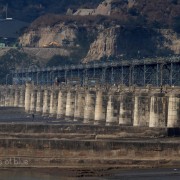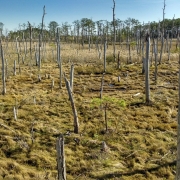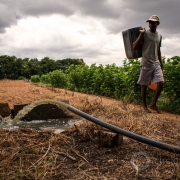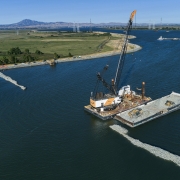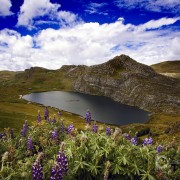Murders of Activists Defending Safe Water and Environment Rise Sharply
Assassins kill without apprehension or prosecution.
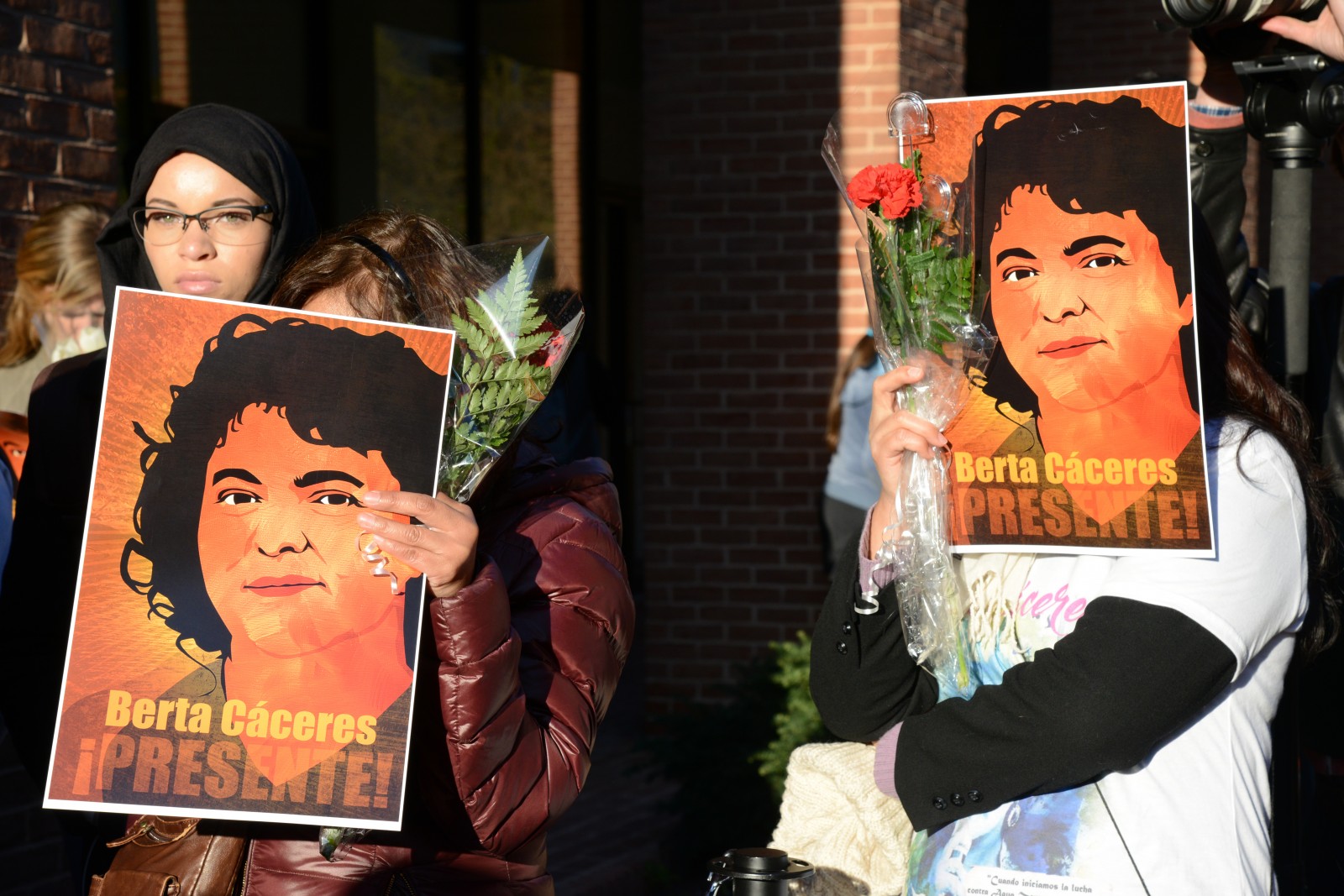
Mourners hold a vigil outside the Organization of American States for Berta Cáceres, who was murdered in Honduras on March 3. Cáceres was a leading environmental activist who had opposed the Agua Zarca dam. Photo courtesy Daniel Cima / Comisión Interamericana de Derechos Humanos via Flickr Creative Commons
By Keith Schneider, Circle of Blue
On the day in late June that Global Witness reported that environmental activists are now being murdered at the rate of three assassinations weekly around the world, one of Panama’s prominent human rights leaders was in Panama City organizing opposition to a big hydropower dam and reservoir in western Panama.
As one of the environmental community’s top public interest strategists, the rights leader has spent years assisting Panama’s Ngäbe community defend four townships and 500 farmers from the 28.4-megawatt Barro Blanco dam and the rising water levels of its big backwater lake.
The $US 78 million dam, financed by Honduran and European investors and supported by the Panama government as a needed addition to electrical generating capacity, has been the focus of furious protest for years. The activist, who asked not to be identified because of concern about his safety, is modest about his role in the campaign that has helped to make him visible in mainstream and social media.
Just how dangerous the work of environmental activists has become was made clearer on June 20 when Global Witness reported that 185 environmental activists were killed around the world last year in 16 countries.
His caution about seeking levels of public prominence are understandable in an unsettling era of clear personal danger for Latin American environmental activists.
“We been involved in several similar campaigns,” said the activist. “In the past, several of our partners and collaborators have faced higher levels of risks than me.”
For example, Ligia Arreaga, a journalist and activist seeking to protect the rainforest that spreads across Panama’s border with Colombia, announced in June that she has received death threats since 2009 for defending the Matusagarati Wetlands Lagoon on the Pacific coast. The ecosystem supports hundreds of species that are in danger from farmers planting crops with the consent of the government.
“The truth is that I have never received any threat like that. I know I need to be careful,” the Panama activist said in an interview with Circle of Blue. “I tell people to be careful. We will continue to fight. But we don’t want to take unnecessary risks.”
Just how dangerous the work of environmental activists has become was made clearer on June 20 when Global Witness reported that 185 environmental activists were killed around the world last year in 16 countries. It was the highest annual death toll on record, said the London-based human rights organization, and represented 69 more eco-activists murdered than in 2014, an increase of 59 percent. It is the highest annual environmental casualty count since Global Witness began compiling data in 2002.
Water-Related Assassinations
Fifteen of those killed in 2015 were specifically involved in opposing threats to fresh water, especially construction of new dams, said Global Witness. Nearly 60 other murders involved leaders of campaigns opposing mining, logging, and other extractive industries. Water supply and water pollution were facets of many of these protests.
No region was more dangerous than Latin America, where 122 environmental activists were killed last year in seven countries. Brazil accounted for 50 murders by itself, said Global Witness.
Though every killing involved distinctive circumstances, common causes also emerged, said Billy Kyte, the lead author of the report, On Dangerous Ground, and the Global Witness senior campaigner.
“As demand for products like minerals, timber and palm oil continues, governments, companies and criminal gangs are seizing land in defiance of the people who live on it,” Kyte said in a statement. “Communities that take a stand are increasingly finding themselves in the firing line of companies’ private security, state forces and a thriving market for contract killers. For every killing we document, many others go unreported.”
Murderers Are Not Caught
Another feature common to so many of the murders is that assassins typically are not identified or prosecuted.
“In the United States people don’t get murdered because they oppose a dam,” John Knox, a law professor at Wake Forest University and the United Nations special rapporteur on human rights and the environment, said in an interview with Circle of Blue. “In a lot of countries it’s not just that you can be harassed. You can be killed. There’s a problem of impunity.
“People are getting killed because their murderers know they can get away with it. Less than 1 percent are apprehended and prosecuted. What do you expect to happen when basically there is no cost? Governments have a responsibility to investigate and prosecute people who are responsible, whether they are influential or not.”
The 2016 Toll Is Equally Grim
In 2016, assassinations of environmental leaders appear to be continuing at a pace similar to that in 2015, according to news reports by Circle of Blue and other media.
In March, Bazooka Radebe was gunned down in South Africa. The leader of the Amadiba Crisis Committee, which opposes a mine and new highway along South Africa’s Wild Coast, Radebe was murdered by two men posing as police officers. His killers have not been identified.
“We will not be intimidated,” Nonhle Mbuthuma, another of the Amadiba Crisis Committee’s leaders and a close friend to Radebe, told Circle of Blue in an interview in February. “Our people are dying over this. That will not stop us.”
People are getting killed because their murderers know they can get away with it. Less than 1 percent are apprehended and prosecuted.” –John Knox, UN special rapporteur on human rights and the environment
The same month two Honduran activists who opposed a big dam project were killed. One of them was Berta Cáceres, the founder of the Council of Indigenous Peoples of Honduras and the winner of the 2015 Goldman Environmental Prize for her work to block a cascade of four dams in the Gualcarque river basin. Police arrested five suspects in Cáceres’ slaying. Two were employees of the company constructing the Agua Zarca dam. A third is an active-duty major in the Honduran army.
Last week another woman, 49-year-old Lesbia Janeth Urquía, who also was a member of Cáceres’ organization, was assassinated in Honduras. Urquía’s body was found abandoned in a rubbish dump 160 km (100 miles) west of the capital, Tegucigalpa.
“It is more important to give visibility to her and to the horrible situation that they are facing in Honduras right now,” said the activist in Panama. “Several of the victims are actually women, which is a terrible trend.”
In June, the body of Nilce de Souza Magalhães was found by the dam of Usina Hidrelétrica (UHE) in Jirau, Porto Velho, Brazil. According to Frontlinedefenders.org, a human rights group, the young woman was active in the Movement of People Affected by Dams, a global group that opposed the dam project that had displaced her community on the Madeira River. She had been missing since early January. On January 15 a suspect, Edione Pessoa da Silva, was brought into custody by the police and confessed to her murder. The suspect escaped from prison shortly afterwards.
“Sometimes environmental defenders become defenders accidentally,” said John Knox, the UN special rapporteur. “They don’t realize how dangerous it is. I’m constantly in awe how brave they are. To continue to fight in the face of incredible death threats. It’s amazing what courage they have.”
In Panama, the campaign to stop the rising waters behind the Barro Blanco dam is the country’s most active and dangerous campaign, and has been since the early years of this decade. Last week, after persistent and focused protests, the government ordered the dam developers to halt filling the backwater reservoir.
In 2012, during protests that blockaded access roads to the dam construction site, Panamanian security forces fired on protestors, killing two people. In March 2013 an activist, Onesimo Rodriguez, was also killed by four masked men. The murder occurred after a demonstration against the Barro Blanco dam. According to local residents, his body was thrown into a nearby stream where it was discovered the following day.
The Panama activist was familiar with the murdered man. He’s a regular presence in the Ngäbe community. “Our work is needed,” said the activist. “We take public positions. We are very careful in what we say.”
Circle of Blue’s senior editor and chief correspondent based in Traverse City, Michigan. He has reported on the contest for energy, food, and water in the era of climate change from six continents. Contact
Keith Schneider




